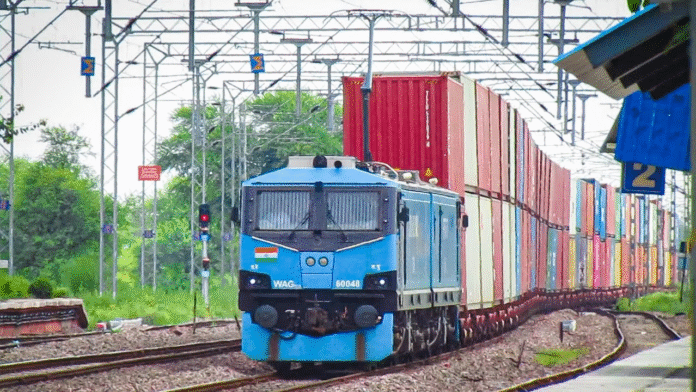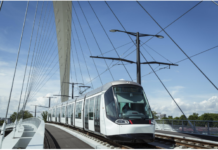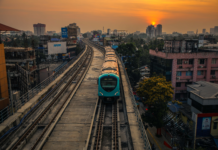Abstract
Over the past decade, India has risen from the 11th to the 4th largest economy globally, which reflects the country’s sustained economic growth and its increasing role in the global economic landscape. According to current projections, India is expected to become the third-largest economy by 2030, with a GDP of approximately $7.3 trillion. This growth is being supported by improvements in supply chain infrastructure, which continues to adapt to the increasing demands of the logistics sector.
In 2024, India’s logistics market generated an estimated revenue of USD 228.4 billion and is projected to reach USD 357.3 billion by 2030. Between 2025 and 2030, the sector is expected to grow at a compound annual growth rate (CAGR) of 7.7%.

India transports approximately 6.3 billion tonnes of freight annually, with the volume of freight movement increasing at an average annual rate of 6% since 2014. Despite these developments, logistics costs in India have remained high, estimated at 14-8% of GDP, compared to the global average of around 8%.
The freight transport sector is dominated by road, which carries about 65% of the total volume, followed by rail at 26%. The remaining 9% is managed through coastal shipping, inland waterways. However, the dominance of road transport in freight movement has contributed to higher greenhouse gas (GHG) emissions and elevated logistics costs. In contrast, rail transport offers a more energy-efficient and cost-effective alternative for moving large volumes of goods over long distances.
The development of Dedicated Freight Corridors (DFCs) has played a key role in improving the share of rail in freight transportation. DFCs are designed to operate high-capacity freight trains on segregated tracks, which will enhance the capacity, reliability, and cost-efficiency of rail-based freight movement. These corridors align with India’s broader objective of creating a more sustainable and competitive logistics ecosystem.
This article examines the role of DFCs in strengthening India’s supply chain infrastructure and their potential contribution to long-term economic development.
Post Independence Era: Decline of Railways’ Share in Freight
After independence, Indian Railways held a dominant position in the country’s freight movement. It inherited a well-established and extensive rail infrastructure, both in terms of track length and rolling stock. In 1950–51, the Indian Railways network spanned 53,956 route kilometres, outpacing the 19,811 kilometres of the National Highway network at the time. This infrastructure advantage enabled railways to carry over 85% of the nation’s freight, which made it the primary mode of goods transportation in post-independence India.
Railways’Capacity in Freight

However, over the decades, the share of rail in freight transport has steadily declined. As of 2022–23, rail’s share has dropped to around 26%, while road transport has grown to dominate with nearly 65% of freight movement.

This shift occurred due to several factors, including the expansion of the national highway network, inadequate railway infrastructure, easier door-to-door delivery through road transport, and the flexibility road transport offers for short-haul and time-sensitive goods. Additionally, limited investment in freight-specific rail infrastructure and longer transit times discouraged industries from relying on railways.
In response, Indian Railways has initiated a strategy to reverse this trend by enhancing rail’s modal share to 40% by 2040, through dedicated freight infrastructure such as the Dedicated Freight Corridors (DFCs).
Dedicated Freight Corridors: An Initiative to Revive Rail’s Dominance in India’s Freight Movement
The Tenth Five-Year Plan (2002–2007) projected a consistent annual increase in freight traffic, estimating a growth rate of 5%. According to this forecast, freight volume was anticipated to escalate from 489 million tonnes in the fiscal year 2001–2002 to 624 million tonnes by the fiscal year 2006–2007. This projection highlighted the necessity for establishing Dedicated Freight Corridors (DFCs). The primary objective of this initiative was to enhance the capacity for rail freight transport, improve operational efficiency, reduce overall transportation costs, and accommodate larger volumes of freight.
In 2005, the Minister of Railways announced plans for the development of high-capacity, high-speed Dedicated Freight Corridors along the Golden Quadrilateral. An additional aim of this initiative was to create a distinct network for freight and passenger trains, thereby facilitating a more streamlined and efficient movement of goods throughout the rail network.
Preparation of DPR: In 2005, RITES was entrusted to carry out feasibility and Preliminary Engineering Cum Traffic Survey (PETS) for both Eastern Dedicated Freight Corridor and Western Dedicated Freight Corridor.
Establishment of DFCCIL: In 2006, the Dedicated Freight Corridor Corporation of India Limited (DFCCIL) was set up with the mandate to plan, develop, and implement the Dedicated Freight Corridors (DFCs). Its responsibilities include mobilising financial resources, overseeing construction, ensuring efficient operation and maintenance, and promoting business development related to the DFCs.
Project Cost & Approval: In February 2008, the Government of India sanctioned the development of the Eastern and Western Dedicated Freight Corridors (EDFC and WDFC), with an initial estimated project cost of ₹28,181 crore. However, the project’s cost has undergone several revisions over time. In June 2015, the Cabinet Committee on Economic Affairs approved the revised budget for the EDFC and WDFC, amounting to ₹81,459 crore. This allocation includes a construction cost of ₹73,392 crore, which comprises a soft cost of ₹19,390 crore, as well as a land acquisition cost of ₹8,067 crore.
The financing for this project has been sourced from a combination of debt from bilateral and multilateral agencies, such as JICA and the World Bank, and equity contributions from the Ministry of Railways. The capital structure of the Dedicated Freight Corridor Corporation of India Limited (DFCCIL) will reflect a debt-to-equity ratio of 3:1.
Route Details: Initially, DFCCIL (Dedicated Freight Corridor Corporation of India Limited) was tasked with developing two Dedicated Freight Corridors (DFCs), the Eastern and Western Corridors, with a total cumulative length of 2,843 kilometres. As of now, 2,741 route kilometres (96.4%) have been commissioned and are operational.
| Corridor | Length | Total Completion Status |
| Eastern Dedicated Freight Corridor | 1337 Km | 2741km (96.4%) |
| Western Dedicated Freight Corridor | 1506 Km |

Eastern Dedicated Freight Corridor: The Eastern Dedicated Freight Corridor (EDFC) is planned to cover a total length of 1,856 km, stretching from Ludhiana (Punjab) to Dankuni (WestBengal). However, DFCCIL is currently implementing a 1,337 km section between Sahnewal (near Ludhiana) and Sonnagar (Bihar) under Phase-1. The remaining 519 km stretch from Sonnagar to Dankuni is planned to be developed under the Public-Private Partnership (PPP) model.
| Section | Length | Status |
| Ludhiana to Sonnagar | 1,337 km | Sanctioned, constructed, and managed by DFCCIL |
| Sonnagar to Dankuni | 519 km | Planned as a PPP project under Phase 2. |
| Total Length | 1,856 km |
| State-wise Route length | |
| Punjab | 88 km |
| Haryana | 72 km |
| UP | 1078 km |
| Bihar | 239 km |
| Jharkhand | 195 km |
| West Bengal | 203 km |
| Total | 1,337 km |
Completion Timeline of Eastern Dedicated Freight Corridor (EDFC)
| Section | Length (Km) | Status | Inauguration Details |
| Sahnewal – Pilkhani | 179 | Commissioned (100% Complete) | 12 March 2024 |
| Pilkhani – Khurja | 222 | Commissioned (100% Complete) | 12 March 2024 |
| Khurja – Dadri | 46 | Commissioned (100% Complete) | 25 January 2024 |
| Khurja – Bhaupur | 351 | Commissioned (100% Complete) | 29 December 2020 |
| Bhaupur – DDU | 402 | Commissioned (100% Complete) | 18 December 2023 |
| DDU – Sonnagar | 137 | Commissioned (100% Complete) | 07 July 2023 |
Western Dedicated Freight Corridor: The Western Dedicated Freight Corridor (WDFC) spans 1,504 km and features a double-line electrified track (2 x 25 kV) which connects Jawaharlal Nehru Port Trust (Maharashtra) to Dadri (Uttar Pradesh). The alignment passes through key locations such as Vadodara, Ahmedabad, Palanpur, Phulera, and Rewari.

The WDFC passes through 5 states, which are mentioned below:
| State-wise Route length | ||
| UP | 19 km | |
| Haryana | 177 km | |
| Rajasthan | 567 km | |
| Gujarat | 565 km | |
| Maharashtra | 178 km | |
Completion Timeline of Western Dedicated Freight Corridor (WDFC)
| Section | Length (Km) | Status | Date |
| Dadri – Rewari | 127 | Commissioned | 25 January 2024 |
| Rewari – Madar | 306 | Commissioned | 7 January 2021 |
| Madar – Palanpur | 353 | Commissioned | 18 June 2022 |
| Palanpur – Makarpura | 290 | Commissioned | 30 September 2022 / 30 October 2023 |
| Makarpura – Sachin | 135 | Commissioned | 12 March 2024 |
| Sachin – Vaitarna | 193 | Commissioned | — |
| Vaitarna – JNPT | 102 | Under Construction | 31 December 2025 |
Update on WDFC: The final section of the Western Dedicated Freight Corridor (WDFC), covering 102 km from Vaitarna to Jawaharlal Nehru Port Trust (JNPT), is currently under construction. A major milestone was recently achieved with the breakthrough of the Kundevahal Tunnel in Panvel, which concludes all tunnelling work along this stretch. While the section was initially expected to be commissioned by March 2025, delays in execution have pushed the deadline to December 2025.
Advanced Rolling Stock Inspection System:In July 2025, Indian Railways entered into a Memorandum of Understanding (MoU) with the Dedicated Freight Corridor Corporation of India Limited (DFCCIL) to implement a Machine Vision Based Inspection System (MVIS). This is used for monitoring the condition of rolling stock. This advanced technology solution, which employs artificial intelligence and machine learning, is installed at the wayside and is capable of capturing high-resolution images of the undercarriage of moving trains. It automatically identifies any hanging, loose, or missing components. Upon detecting anomalies, the system generates real-time alerts, enabling timely interventions and preventive measures to enhance operational safety and efficiency.

A Long-Term Vision for Freight Mobility: New DFC Alignments in India
As part of the long-term vision to enhance freight transportation efficiency, the Ministry of Railways (MoR) announced in the 2016 Union Budget its intent to develop three new Dedicated Freight Corridors in addition to the already operational Eastern and Western DFCs.
Initially, the following corridors were proposed:
| Corridor Name | Route | Length (Approx.) |
| East–West Corridor | Kolkata to Mumbai | 2328 km |
| North–South Corridor | Delhi to Chennai | 2327 km |
| East Coast Corridor | Kharagpur to Vijayawada | 1114 km |
| Southern Corridor | Madgaon – Ankola – Rinigunta | 893 km |
Planning and Preliminary Work
To initiate development, RITES Ltd., a public sector enterprise under the Ministry of Railways, was entrusted to carry out the Preliminary Engineering cum Traffic Surveys for these proposed corridors. Based on these studies, RITES submitted the reports to the Railway Board for administrative approval and further action.

Administrative Approval for DPR Preparation
In 2022, Indian Railways approved the preparation of Detailed Project Reports (DPRs) for new Dedicated Freight Corridors (DFC) on three routes:
- East Coast Corridor
- East–West Corridor
- North–South Corridor
This responsibility to prepare DPRs for these was formally assigned to the Dedicated Freight Corridor Corporation of India Limited (DFCCIL).
Corridor Alignments as per Approval
| Corridor Name | Sub-Corridor | Route | Length (km) |
| East Coast Corridor | — | Kharagpur – Vijayawada | 1115 |
| East–West Corridor | Sub-Corridor A | Bhusawal – Wardha – Nagpur – Rajkharsawan – Kharagpur – Uluberia – Dankuni | 1673 |
| Sub-Corridor B | Rajkharsawan – Kalipahari – Andal | 195 | |
| North–South Corridor | Sub-Corridor | Vijayawada – Nagpur – Itarsi | 972 |
Note: As of now, none of the above-mentioned corridors have received final sanction for implementation.
Primary Challenges in the Dedicated Freight Corridor (DFC) Project

1. Development of Advanced Locomotives: At present, the axle load capacity of Dedicated Freight Corridor Corporation of India Limited. is designed for 25-ton axle load. However, there is a need to develop the rolling stocks capable of sustaining higher axle loads of 25 tonnes to 32.5 tonnes. These wagons must be structurally stronger to accommodate heavier freight while maintaining safety standards. WAF-12B is the most powerful locomotive currently used by DFCCIL in its operations. It has a power output of 12,000 HP and is designed with an axle load capacity of 22.5 tonnes, which can be upgraded to 25 tonnes. The locomotive is capable of achieving a design speed of 120 kmph. The introduction of high-horsepower locomotives is essential, as they will be required to haul longer and heavier trains at greater speeds.
2. Establishment of Multimodal Logistic Parks (MMLPs): To unlock the potential of DFCs, it is imperative to develop the logistics parks along the corridors, which will serve as hubs for freight consolidation, distribution, and multimodal transfers. These parks must be equipped to handle intermodal connectivity (rail-road-port-air), warehousing, customs clearance, and allied services such as container handling. Without these facilities, the benefits of faster and more efficient freight movement could remain underutilised. The government has sanctioned the establishment of 35 locations for the development of Multi-Modal Logistics Parks across India. Among the approved locations, five Multimodal Logistics Parks (MMLPs) located in Jogighopa, Chennai, Bengaluru, Nagpur, and Indore are currently under development. These facilities are anticipated to become operational in the fiscal years 2025-26 and 2026-27.
Impact of Dedicated Freight Corridors on India’s Logistics Sector
Reduction in Logistics Cost: The logistics costs in India have been substantially high due to the predominance of road transport within the sector. However, the establishment of DFCs will increase the railways’ share in freight transportation, which is comparatively more economical than road transport. This transition is anticipated to reduce overall freight and logistics expenses. In addition to this, DFCs will support India’s broader vision of reducing logistics costs to below 8% of GDP.
Industrial Development: DFCs facilitate the establishment of industrial zones, logistics parks, and container terminals along their routes, which attract investments and generate employment opportunities in various regions, including those that have historically been less industrialised.
Decongestion of Existing Lines: Indian Railways manages the fourth-largest railway system in the world and operates over 13,000 trains a day. On the existing lines, congestion is primarily caused by the sharing of tracks between passenger and freight trains. As of October 2024, DFCs were handling approximately 13% of India’s total railway freight load, up from about 10% in July 2024, despite the DFC network accounting for only about 4% of the overall rail network. The expansion of DFCs will not only decongest lines but also help to achieve the goal of increasing the rail share in freight transport to 45% by 2030.
Lower Carbon Emissions: DFCs primarily use electric locomotives, resulting in a reduction in greenhouse gas emissions compared to diesel-propelled trains and road transport. Estimates suggest DFCs will generate 2.25 times fewer greenhouse gas emissions over 30 years. In the fiscal year 2013-2014, the railway system transported approximately 1,055 million tons of cargo. This figure has increased to 1,617 million tons by the year 2024-2025, positioning our railway as the second largest cargo-carrying railway in the world. Based on analyses conducted by experts, this transition of cargo transportation from road to rail has contributed to a reduction of over 143 million tons of carbon dioxide emissions within our country.

Projection of GHG emissions due to freight transportation by DFC (in million tons CO2)
Conclusion
The Dedicated Freight Corridor project represents a shift in India’s freight transportation strategy. It aims to enhance railways’ efficiency in moving freight, reduce logistics costs, and support sustainable growth of logistics sector. DFCs will play a critical role in lowering logistics expenses while offering a more sustainable alternative to road transport. Their expansion will help reduce congestion on existing railway lines and improve passenger train frequency. However, challenges related to infrastructure expansion and technology integration must be addressed. Successful implementation will be essential for achieving India’s objective of developing a more competitive, environmentally responsible, and globally aligned freight transportation system.






Dedicated Freight Corridors are a major boost for India’s logistics sector, enabling faster, cost-efficient, and sustainable movement of goods. A big step forward in strengthening the nation’s supply chain and supporting economic growth.